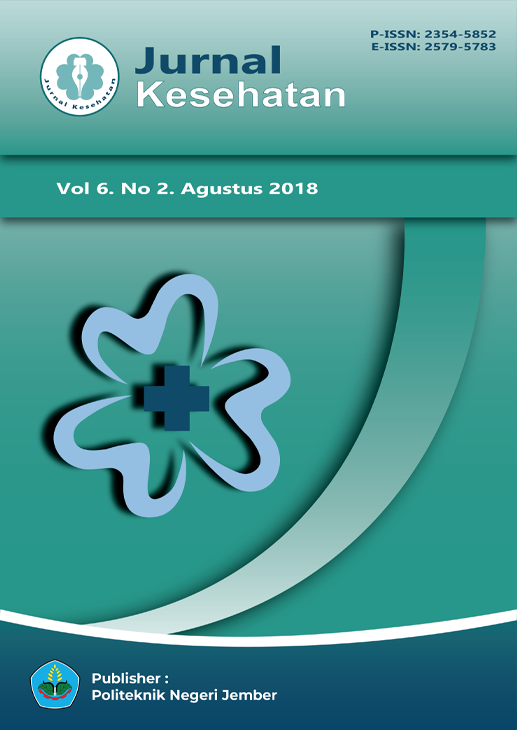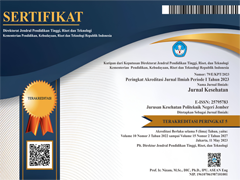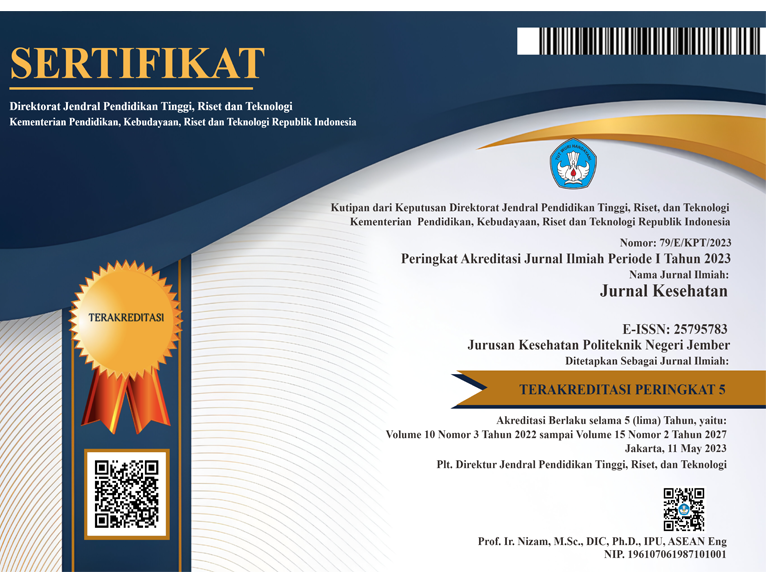Determinan Stres Kerja Pada Penjaga Palang Pintu Rel Kereta Api Resmi Resort 9.6 Daerah Operasi IX Di Kabupaten Jember
DOI:
10.25047/j-kes.v6i2.13Issue:
Vol. 6 No. 2 (2018): AgustusArticles
Downloads
How to Cite
Downloads
Abstract
Abstract
Transportation sector development is one of the sub sectors that is important to support economic development. Poor transportation sector will develop human activities. One type of transportation is a train that has a special line and avoid congestion, Sometimes the train also cut off the highway, so the railway door is made to function to secure the train journey and guarded the door keepers. The problem in the concern at PT KAI is human error, One example of human error is a door keepers undisciplined in closing the railway door gates. One of the danger areas is Jember Regency which is located in DAOP IX, it is because Jember Regency had the most railway door in DAOP IX and has many crossings in the settlement area. The results of observations before the study found some workers who show symptoms of work stress. Jember regency had 12 official railway door and there are 47 door keepers who are all male. The door keepers are mostly 25-40 years old, have a working period of 1-5 years, have married marriage status, and have children <3, have wage / salary Rp.1.500.000-Rp.3.500.000, almost half of the respondents experienced fatigue and severe stress. The results of the study found there is a relationship between age, employment, marital status, wages / salary with work stress, but fatigue and wages/salary are not related to work stress.
Keywords: Work Stress, Human error, Door keepers.
References
Undang-Undang Republik Indonesia Nomor 23 tahun 2007 tentang Perkeretaapian
KNKT. 2016. Data Investigasi Kecelakaan Perkeretapian Tahun 2010-2016.[Online].http://knkt.dephub.go.id/knkt/ntsc_homeMedia_Release /Media%20Release%20KNKT%202016/Media%20Release%202016%20-%20IK%20 KA%2020161130.pdf.[Diakses pada 27 November 2017]
Sopiah, 2008, Perilaku Organisasional, Yogyakarta, Andi Offset.
Tarwaka. 2014. Ergonomi Industri – Dasar-dasar Pengetahuan Ergonomi dan Aplikasi di Tempat Kerja. Surakarta: Harapan Press Solo
NIOSH. 1999a. Stress At Work. What Can Be Done About Job Stress? .[Online]. http://www.cdc.gov/niosh/docs/99-101/pdfs/99-101.pdf. [Diakses 6 Desember 2017]
Tarwaka, 2013, Ergonomi Industri Dasar-Dasar Pengetahuan Ergonomi dan Aplikasi di Tempat Kerja, Surakarta, Harapan Press Solo
.
Suma’mur. 2014. Higiene Perusahaan dan Kesehatan Kerja (HIPERKES). Jakarta: CV Sagung Seto 111
Shute, N. 2009. Having Children Adds Stress to Marriage. [Online]. http://health.usnews.com/healthnews/blogs/onparenting/2009/04/13/havingchildren-adds-stress-to-marriage . [diakses 7 Desember 2017]
Badan Pusat Statistik. 2014. Penggolongan Tingkatan Gaji. [Online].http://jateng.bps.go.id/webbeta/frontend/linkTabelStatis/view/id/655.[ diakses tanggal 20 Maret 2018]
Mangkunegara. A.P. 2013.Manajemen Sumber Daya Manusia. Perusahaan. Bandung: PT. Remaja Rosda Karya
Hariyati, M. 2011.Pengaruh Beban Kerja terhadap Kelelahan Kerja pada Pekerja Linting Manual Dipt. Djitoe Indonesia Tobacco Surakarta. Skripsi. Surakarta: Fakultas Kedokteran Universitas Sebelas Maret.
Yudha F.P. 2010.Faktor yang Berhubungan dengan Kejadian Stres Kerja pada Bagian Produksi Industri Mebeul PT. Chia Jiann Indonesia Furniture di Wedelan Jepara Tahun 2009. Skripsi. Semarang. Universitas Negeri Semarang Jurusan Ilmu Kesehatan Masyarakat
.
Melindasari, I,. 2015. Pengaruh Lingkungan Kerja dan Stres Kerja Terhadap Kinerja Karyawan PT. Federal International Finance (FIF) Gresik. Sripsi. Gresik: Fakultas Ekonomi Universitas Wijaya Putra Surabaya
Olatunji, & Mokuolu, B. (2014). The Influence of Sex, Marital Status, and Tneure of Service on Job Stress, and Job Satisfaction of Health Workers in a Nigerian 191 Federal Health Institution. Jurnal Internasional, Vol 8, No.1, 126-133
License
Authors who publish in this journal agree to the following terms:
1. Copyright belongs to the medical journal as a publication
2. The author retains copyright and grants the journal rights to the first publication carried out simultaneously under a Creative Commons Attribution License which allows others to share the work with an acknowledgment of the author's work and initial publication in this journal.
3. Authors may enter into separate additional contractual arrangements for the non-exclusive distribution of the work (eg sending it to an institutional repository or publishing it in a book) with acknowledgment of initial publication in this journal.
4. Authors are permitted and encouraged to post work online (eg in institutional repositories or on their websites) before and during the submission process, as before and larger citations of published work (see Effects of Open Access).
Selengkapnya tentang teks sumber ini














